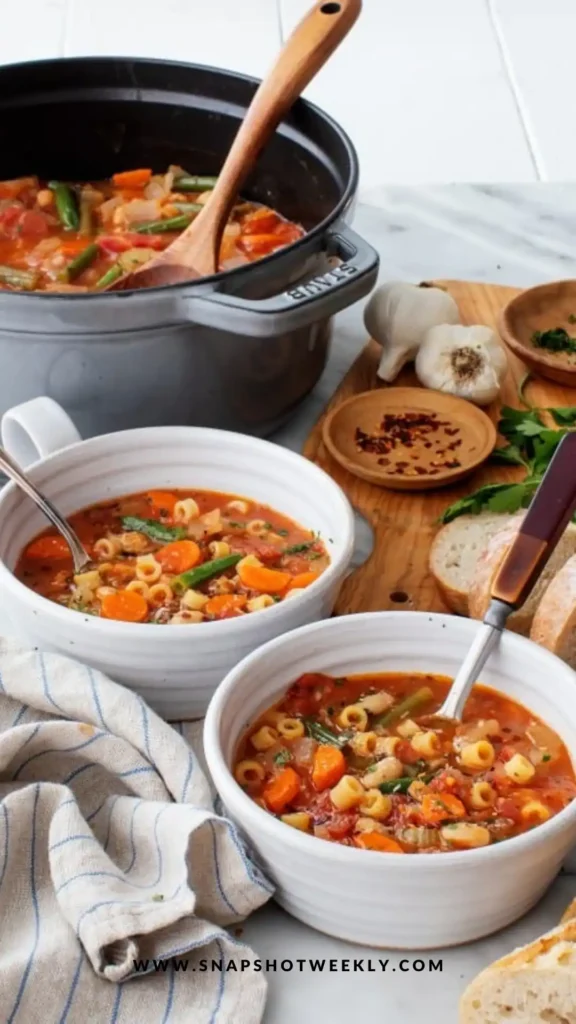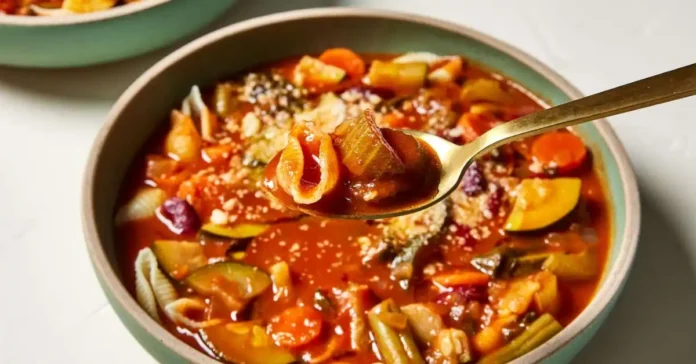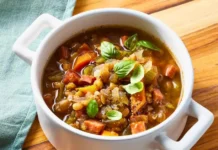I’m so excited to share my Minestrone Soup recipe with you! This isn’t just any soup — it’s a cozy, hearty Italian vegetable soup that feels like a warm hug in a bowl. It’s loaded with tender veggies, creamy beans, and tiny pasta swimming in a tomato-herb broth. All you need is a slice of crusty bread on the side, and you’ve got a complete, comforting meal.
Level: Easy
Total Time: 45 minutes
Prep Time: 15 minutes
Cook Time: 30 minutes
Yield: 4–6 servings
Course: Soup, Main Dish
Cuisine: Italian / Vegetarian
I still remember the first time I made minestrone soup on a chilly evening after baking holiday cookies — it instantly became my new favorite. After a day of making something sweet, there’s nothing better than a light yet filling pot of veggie-packed soup for dinner.
This recipe is satisfying but still fresh, thanks to onions, carrots, and celery creating a flavorful base, beans and pasta adding thickness, and green beans bringing a nice bite. A sprinkle of fresh parsley and Parmesan cheese at the end makes it extra special. Whether you’re feeding your family, meal-prepping for the week, or just craving a wholesome bowl of comfort, this recipe will hit the spot.
How to Make Minestrone Soup
This classic Italian soup is simple, flexible, and nourishing. Here’s what makes it special:
- A savory base of onion, carrot, and celery for depth of flavor.
- Garlic and herbs to make the broth fragrant and rich.
- Canned tomatoes for that perfect sweet-tangy taste.
- White beans or kidney beans for creaminess and protein.
- Tiny pasta that cooks right in the pot, making it thicker and heartier.
- Fresh parsley and Parmesan for a bright, finishing touch.
It’s a one-pot wonder that’s easy to customize with whatever veggies you have on hand.
Ingredients
- 2 tablespoons extra-virgin olive oil
- 1 medium yellow onion, diced
- 2 medium carrots, chopped
- 2 celery ribs, thinly sliced
- 1 teaspoon sea salt, plus more to taste
- Freshly ground black pepper
- 3 garlic cloves, grated or minced
- 1 (28-ounce) can diced tomatoes (with juices)
- 1½ cups cooked white beans or kidney beans (drained and rinsed)
- 1 cup chopped green beans
- 4 cups vegetable broth
- 2 bay leaves
- 1 teaspoon dried oregano
- 1 teaspoon dried thyme
- ¾ cup small pasta (elbows, shells, orecchiette, or ditalini)
- ½ cup chopped fresh parsley
- Red pepper flakes (optional, for a little heat)
- Grated Parmesan cheese (optional, for serving)
Directions
- Prepare the Ingredients:
- Dice the onion, carrots, and celery into small, even pieces.
- Mince the garlic and chop the green beans.
- Make sure your beans are rinsed and your broth is ready to pour.
- Cook the Vegetable Base (8 minutes):
- In a large pot or Dutch oven, heat the olive oil over medium heat.
- Add the onion, carrots, celery, salt, and a few grinds of black pepper.
- Stir and cook for about 8 minutes until the vegetables are soft and fragrant.
- Add Garlic and Build the Broth:
- Stir in the garlic and cook for about 30 seconds, just until you smell it.
- Add the diced tomatoes with their juices, beans, green beans, vegetable broth, bay leaves, oregano, and thyme.
- Stir everything together.
- Simmer the Soup (20 minutes):
- Bring the pot to a gentle boil, then reduce the heat to low.
- Cover and simmer for 20 minutes so all the flavors blend.
- Cook the Pasta in the Soup (10 minutes):
- Stir in the small pasta.
- Cook uncovered for about 10 minutes, stirring occasionally, until the pasta is tender.
- Finish and Serve:
- Remove the bay leaves.
- Stir in the chopped parsley and taste the soup. Add more salt, pepper, or red pepper flakes if you like.
- Ladle into bowls and top with grated Parmesan cheese, if desired.
Process Details
- Why cook the veggies first? Cooking onions, carrots, and celery slowly at the start makes them sweet and gives the broth real depth.
- Why add garlic later? Garlic burns easily. Adding it after the veggies keeps its flavor bright.
- Why simmer before pasta? This lets the beans, tomatoes, and herbs share their flavors without the pasta soaking up too much broth.
- Why cook pasta in the soup? Pasta releases a little starch, which makes the broth thicker and more satisfying. If you want to store leftovers, cook pasta separately and add it to each bowl when serving.

Tips for Success
- Salt gradually: A little at the start helps vegetables soften; adjust at the end for flavor.
- Customize the veggies: Swap green beans for zucchini, squash, or spinach.
- Make it vegan: Skip Parmesan and top with olive oil or vegan pesto.
- Heartier option: Add cooked farro or barley instead of pasta.
- Meal-prep friendly: Cook the pasta separately if you plan to store leftovers so it won’t soak up too much broth.
Serving Ideas
- Classic: Serve hot with crusty bread to soak up the broth.
- Salad Pairing: Pair with a fresh side salad — arugula, beet, or pear salad all work beautifully.
- Protein Boost: Add cooked sausage or shredded chicken for a non-vegetarian twist.
- Topping Upgrade: Stir a spoonful of regular or vegan pesto into each bowl for extra flavor.
Storage & Freezing
- Refrigerator: Store in an airtight container for up to 4 days. Add extra broth when reheating if pasta has absorbed too much liquid.
- Freezing: Freeze the soup without pasta for best results. Thaw overnight and cook fresh pasta when ready to serve.
Nutrition Info (Approximate per Serving)
- Calories: ~250
- Protein: 10g
- Carbohydrates: 40g
- Fat: 7g
- Fiber: 8g
- Sodium: 700mg
My Minestrone Soup recipe is the perfect blend of fresh veggies, creamy beans, and tiny pasta simmered in a tomato-herb broth. It’s simple, wholesome, and endlessly adaptable — exactly the kind of recipe you’ll make again and again. Serve it with crusty bread, sprinkle on some Parmesan or a spoonful of pesto, and you’ve got a bowl of comfort that’s as satisfying as it is nourishing.
Enjoy making (and eating!) this soup as much as I do — it’s a cozy classic you’ll keep in your recipe rotation.












